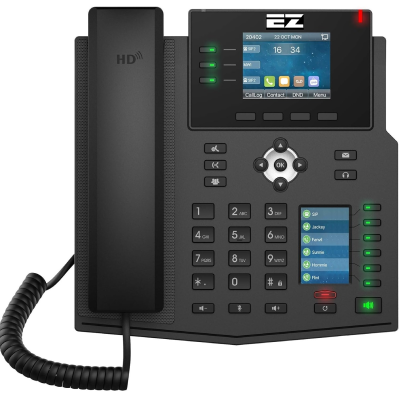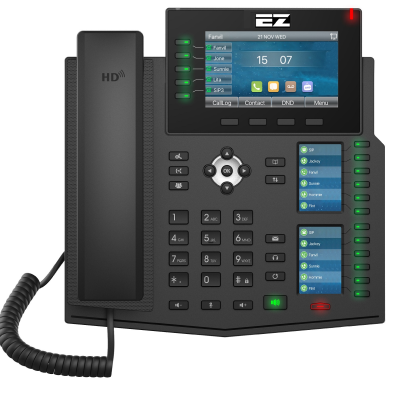
SIP Phones
Session Initiation Protocol (SIP) phones are the unsung heroes of modern communication systems. SIP, a signaling protocol used for initiating, maintaining, modifying, and terminating real-time sessions that involve video, voice, messaging, and other communications applications and services, is the backbone of these devices.
At their core, SIP phones are communication devices that leverage the SIP protocol to make voice and video calls over the internet. They’ve revolutionized the way we connect in professional environments, offering a cost-effective and feature-rich alternative to traditional telephone systems.
One of the key advantages of SIP phones is their flexibility. They operate over the internet, allowing users to make calls from anywhere with an internet connection. This makes them particularly valuable for businesses with remote or distributed teams. Whether you’re in the office, at home, or on the go, a SIP phone keeps you seamlessly connected.

EZX4U
- Wideband codec G.722 and Opus
- 2.8-inch 320 x 240-pixel color side display
- T2.4 inch 240 x 320-pixels color side display
- 12 SIP Lines
- 30 DSS keys, 3 line keys with LED light
- Dual Gigabit port, PoE integrated
- Bluetooth
- Support EHS wireless headset

EZ6XU
- Wideband codec G.722 and Opus
- 4.3-inch 480 x 272-pixel color display
- Two 2.4 inch 240 x 320-pixels color side display
- 20 SIP Lines
- 60 DSS keys, 5 line keys with LED light
- Dual Gigabit port, PoE integrated
- Bluetooth
- Support EHS wireless headset
SIP Trunking
What is SIP trunking? SIP trunks transmit voice and other data over the Internet, digitally, instead of using the traditional protocols and hardware of the PSTN. SIP trunks enable businesses to replace fixed POTS lines with internet connectivity — as long as your hotel has a quality high-speed internet connection, you don’t need any extra infrastructure.
Why Use SIP Trunking?
SIP trunking allows calls to be transmitted over the internet connection, bypassing the local phone company and their charges. Any data that your voice calls use is fraction of the cost compared with web browsing and streaming video, and that data will simply be rolled into the cost of your internet bill. As mentioned previously, SIP trunks are also less expensive for long-distance calls. In many cases, SIP trunk providers include all long distance calls in the monthly flat price of a SIP trunk for calls made in the US and Canada. Calls to other countries are still typically 30 to 50% less than telco rates.
With careful planning, there aren’t any significant drawbacks to SIP trunking. You just need to ensure that your hotel is equipped with enough bandwidth to handle your typical day-to-day call traffic, and ensure your network’s integrity by managing network traffic to optimize voice communications over the data network.
Telecommunications is moving forward at an incredible rate and most business can’t afford to let their communications technology fall behind. If you want to know more about SIP trunking and how to bring your hotel or business technology up to speed contact us today!

 Support Guides & FAQ
Support Guides & FAQ